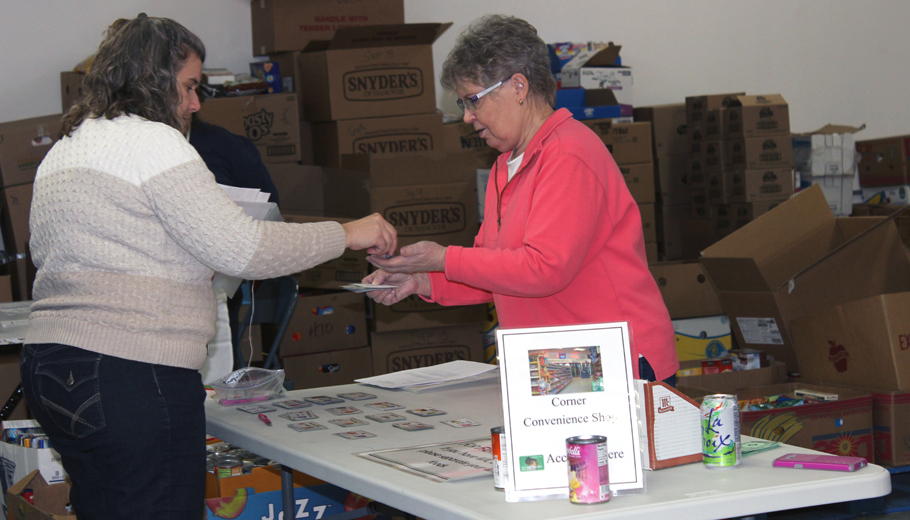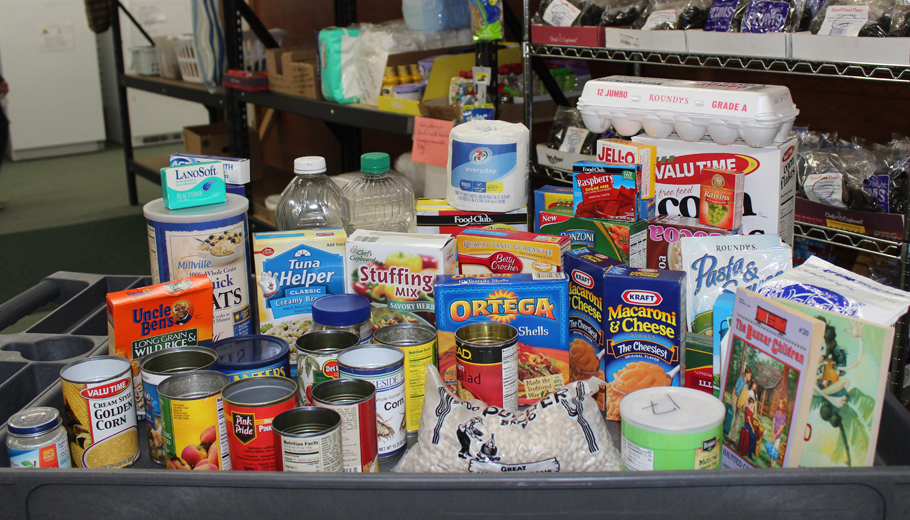Event simulates experience of food insecurity
By Angie Landsverk
Some area residents got an idea of what it is like to experience food insecurity during a hunger simulation.
The simulation took place Friday, Nov. 2, at the Waupaca Area Food Pantry.
UW-Extension’s FoodWise program and the food pantry organized it.
“This hunger simulation focuses on the nutrition aspect of hunger, the hardships of getting food on the plate and what some of our community members deal with and go through to get food on their plate,” said Christi Gabrilska.
She is the UW-Extension FoodWise nutrition coordinator for Calumet, Outagamie, Waupaca and Winnebago counties.
FoodWise is a federally funded program that serves Wisconsin residents who have limited incomes.
It seeks to help people make healthy choices.
Kelly Hammond is Waupaca County’s FoodWIse nutrition educator.
She brings educational information and food samples to the local food pantry.
Linda Holtebeck, president of the pantry’s board, explained why FoodWise and the pantry decided to partner on this simulation.
“We started talking about those who needed food and people who need to understand where they are coming from,” she said. “Kelly had access to a hunger simulation. It developed from there. We’re happy to use our facility and get community members into an understanding mode.”
Close to 30 people participated in the simulation.
About 15 people did so as those experiencing poverty, and about a dozen people participated as workers at the various stations.
The simulation included seven stations.
They were Health and Human Services, a grocery store, food pantry, farm market, community garden, community kitchen and convenience store.
The participants included people who work at Waupaca County’s courthouse and those who volunteer at the food pantry.
Gabrilska said a group of UW-Extension educators adapted the hunger simulation in 2014.
“It’s not a game,” she said. “It really reflects families in our community.”
Hammond said, “We are using the simulation to represent real people in our community. Everyone volunteering at the stations will also be in character as far as how they treat people.”
Those participating as people experiencing poverty received packets when they arrived at the pantry.
The information in it included the size of their family, their finances and food needs.
Gabrilska said the idea was to show participants the challenges families on limited incomes face accessing healthy and nutritious food.
The participants first had to create budgets.
After paying their bills, they then had to get enough food for three meals for themselves and their families using the MyPlate guidelines.
Some of the stations required transportation.
One volunteer represented a bus driver, and not all of the participants had bus passes.
Some had to buy them.
Gabrilska said transportation is an issue for many people.
“Not all households have access to a vehicle,” she said.
Kathy Jenner, the volunteer operation manager at the food pantry, said people network and share cabs to get to the pantry.
“We will see vanloads of clients come together, who are not related, coming to the pantry because there is no bus transportation (here),” she said.
Marian Potts volunteers at the food pantry and was among those participating in last week’s hunger simulation.
She did so as the person working at the convenience store station.
What she witnessed during the simulation is what she often sees when she volunteers at the pantry.
“They (the participants) were more concerned with money than a healthy diet,” Potts said. “We see that.”
Some who participated in the simulation were struck by how their budgets did not include money for clothing or medical costs.
One person said the community garden station was wonderful in providing free food, but then noted it was a seasonal option.
“A lot of times, the nutritional value of food is not that important,” Gabrilska said of those living in poverty.
Hammond said many are trying to get through each day.
“I think that’s reality,” she said.
A participant whose scenario included having a vehicle saw how she had more time and freedom to access food.
One person said her strategy was to first go where she could get free food.
Holtebeck said many people who visit the food pantry do not have facilities for cooking or baking.
Some do not have storage for large, frozen items.
Gabrilska said holding the hunger simulation at the pantry was intentional.
“They are such a great partner, and it was also to show where it is and what people can walk away with from here,” she said.
People who live in the Waupaca School District may visit the pantry once a month.
Located at 800 Churchill St., the pantry is open from 9-11 a.m. on Monday, Wednesday and Friday.
Jenner said the amount of food people receive is meant to sustain them for up to two weeks.
In emergency situations, the pantry helps people from outside the school district.
It also tells them where there is a food pantry in their communities, Jenner said.
She said the people they see are trying to balance life.
Holtebeck said the simulation was to give “an understanding of what people have to go through that are strapped financially.”


